Holiday seasons like Valentine’s Day stand as pivotal moments for brands to cultivate consumer engagement and drive sales, leveraging the emotional resonance inherent on such occasions. Once a simple celebration of affection, February 14th has evolved into a grand marketing spectacle, wielding immense economic influence across diverse industries.
In fact, in 2024, Valentine’s Day expenditures in the United States are projected to soar to a staggering $26 billion (Statista, 2024). These figures underscore the burgeoning opportunity that this day represents for brands.
Therefore, it is legitimate to ask, how brands can leverage design strategies to maximize consumer engagement and drive sales during Valentine’s Day, as an opportunity to forge deeper connection with their audience.
Situationships.
In today’s dynamic landscape of relationships, the concept of “situationships” has emerged as a prominent phenomenon, especially among younger generations. According to a 2022 survey conducted by YPulse, 20% of Gen Z and 16% of Millennials report they have been in a situationship. And 35% of Gen z say they prefer to have an undefined relationship rather than one with a label, highlighting the evolving nature of modern love dynamics.
The campaign quickly gained traction on social media platforms, garnering over 1.2 million views on TikTok and sparking engagement from users who resonated with how confusing situationships can be. The brand’s website further extends the campaign’s reach with downloadable e-cards bearing phrases like “Do you know how much you mean to me? Because I don’t.” adding a touch of humor and authenticity to their Valentine’s Day strategy. This approach exemplifies how brands can adapt to evolving consumer behaviors and cultural trends, infusing their offerings with relevance and resonance.
Dating apps.
Today’s romantic landscape is inseparable from dating apps. With 2.3 million daily unique visitors to these platforms in France in 2023, dating apps have become an essential aspect of modern romance. Consequently, they represent a significant business opportunity for brands aiming to expand their audience reach, enhance visibility, and engage users in meaningful ways by addressing real-life challenges.
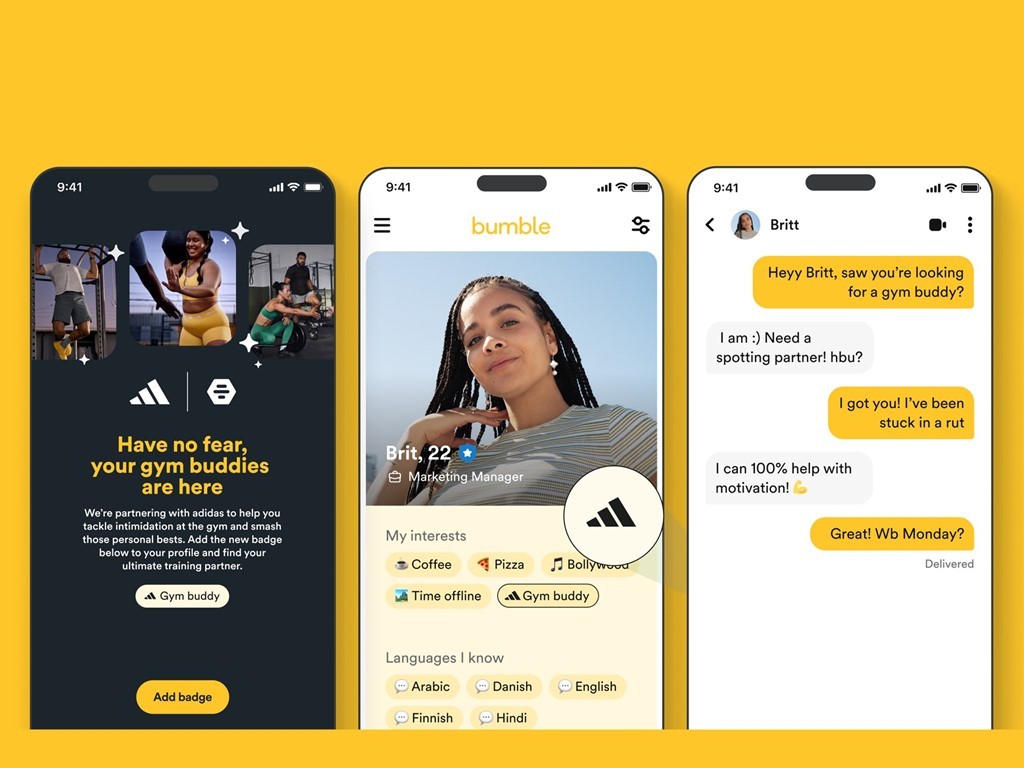
Source: Adidas
For example, Adidas and Bumble have collaborated to introduce a Gym Buddy Interest Badge on the dating app. This badge simplifies the process of finding potential gym partners who share a passion for staying active. The collaboration is in line with the launch of Adidas’s Spring/Summer 2024 Strength collection, showcasing the boundless potential of brand partnerships.
In another partnership, Tinder and Merci Handy have unveiled a capsule beauty collection named “First Date Heroes“. Inspired by an IFOP study for Tinder, which revealed that 74% of 18-25 year olds in France feel stressed before a date, this kit aims to ease the anxiety of first encounters. Additionally, 10% of proceeds from the collection are donated to Consentis, an association advocating for a culture of consent and combating sexual violence in social settings. This collaboration leverages Valentine’s Day as an opportunity to raise awareness of relevant issues and offer solutions that resonate with contemporary dating culture.
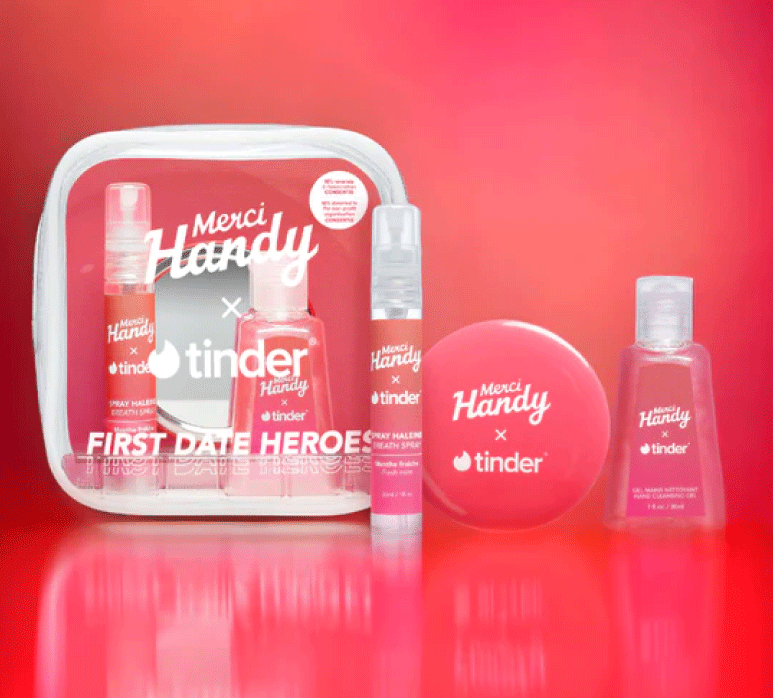
Source: Merci Handy
The increasing impact of AI is transforming how brands operate, presenting a new frontier in personalization and connection for both audiences and marketers. In the United States, 81% of consumers are open to AI providing personalized communications, underscoring the validity of its integration into communication and marketing strategies, especially evident during Valentine’s Day campaigns.
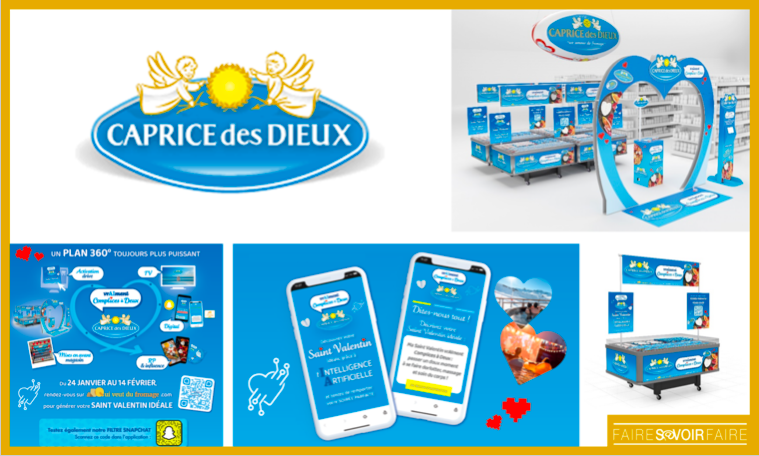
Source: Faire Savoir Faire

Source: Little Black Book
As for holiday season, Valentine’s Day is an opportunity for brands across all sectors to capitalize on the festive spirit by releasing limited edition products and redesigning their packaging. These special releases, ranging from beauty to food items, serve as simple but effective ways to engage consumers and drive sales.
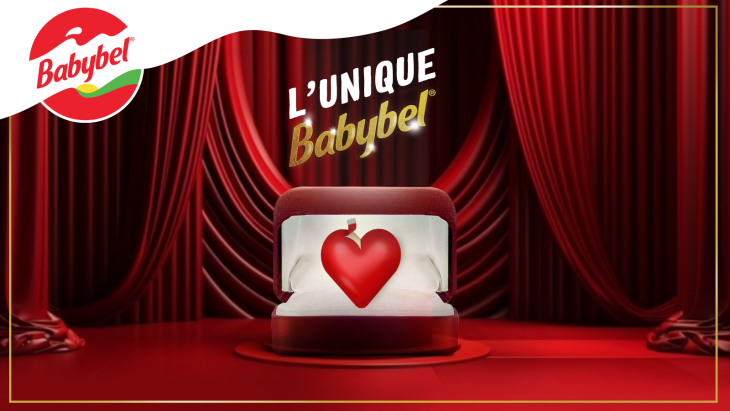
Source: The grocer
For instance, Babybel celebrates Valentine’s Day with a heart-shaped mini variant of its iconic cheese. However, this special edition isn’t available for purchase in stores; instead, consumers must participate in a sweepstake on Babybel’s Instagram page to win it. This approach not only generates excitement but also amplifies the visibility of the limited edition.
Barilla celebrates Valentine’s Day by introducing heart-shaped pasta, accompanied by special recipes for a romantic evening. Meanwhile, Manly Man Co.‘s Meathearts puts a savory twist on the sweet candy hearts with playful messages like “MEET ME”.
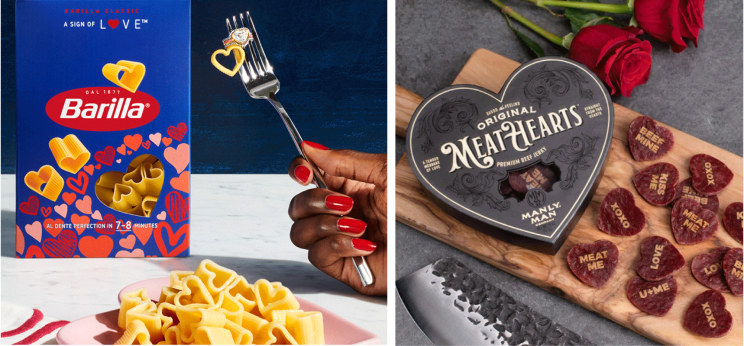
Source: Barilla, Manly Man Co

Source: Fauchon
Heinz celebrated the attraction of opposites with Fauchon Paris through the introduction of the Tomacaron: a macaron with ketchup. This limited edition isn’t just a culinary collaboration; it’s a testament to the power of collaboration that unlocked new opportunities to showcase their respective strengths, broaden their audience reach, and unveil a product that captures the imagination of consumers.
Thus, with the constant evolution of trends, technology, and consumer behaviors, brands have a wide range of options to capitalize on Valentine’s Day. They can leverage the latest technological advancements and emerging trends such as “situationships” and artificial intelligence, or opt for more traditional strategies like limited editions. By integrating these approaches in innovative and thoughtful ways, brands can strengthen their position in the market and foster lasting relationships with their audience during Valentine’s Day and beyond.
Holiday seasons like Valentine’s Day stand as pivotal moments for brands to cultivate consumer engagement and drive sales, leveraging the emotional resonance inherent on such occasions. Once a simple celebration of affection, February 14th has evolved into a grand marketing spectacle, wielding immense economic influence across diverse industries.
In fact, in 2024, Valentine’s Day expenditures in the United States are projected to soar to a staggering $26 billion (Statista, 2024). These figures underscore the burgeoning opportunity that this day represents for brands.
Therefore, it is legitimate to ask, how brands can leverage design strategies to maximize consumer engagement and drive sales during Valentine’s Day, as an opportunity to forge deeper connection with their audience.
Situationships.
In today’s dynamic landscape of relationships, the concept of “situationships” has emerged as a prominent phenomenon, especially among younger generations. According to a 2022 survey conducted by YPulse, 20% of Gen Z and 16% of Millennials report they have been in a situationship. And 35% of Gen z say they prefer to have an undefined relationship rather than one with a label, highlighting the evolving nature of modern love dynamics.
The campaign quickly gained traction on social media platforms, garnering over 1.2 million views on TikTok and sparking engagement from users who resonated with how confusing situationships can be. The brand’s website further extends the campaign’s reach with downloadable e-cards bearing phrases like “Do you know how much you mean to me? Because I don’t.” adding a touch of humor and authenticity to their Valentine’s Day strategy. This approach exemplifies how brands can adapt to evolving consumer behaviors and cultural trends, infusing their offerings with relevance and resonance.
Dating apps.
Today’s romantic landscape is inseparable from dating apps. With 2.3 million daily unique visitors to these platforms in France in 2023, dating apps have become an essential aspect of modern romance. Consequently, they represent a significant business opportunity for brands aiming to expand their audience reach, enhance visibility, and engage users in meaningful ways by addressing real-life challenges.

Source: Adidas
For example, Adidas and Bumble have collaborated to introduce a Gym Buddy Interest Badge on the dating app. This badge simplifies the process of finding potential gym partners who share a passion for staying active. The collaboration is in line with the launch of Adidas’s Spring/Summer 2024 Strength collection, showcasing the boundless potential of brand partnerships.
In another partnership, Tinder and Merci Handy have unveiled a capsule beauty collection named “First Date Heroes“. Inspired by an IFOP study for Tinder, which revealed that 74% of 18-25 year olds in France feel stressed before a date, this kit aims to ease the anxiety of first encounters. Additionally, 10% of proceeds from the collection are donated to Consentis, an association advocating for a culture of consent and combating sexual violence in social settings. This collaboration leverages Valentine’s Day as an opportunity to raise awareness of relevant issues and offer solutions that resonate with contemporary dating culture.

Source: Merci Handy
The increasing impact of AI is transforming how brands operate, presenting a new frontier in personalization and connection for both audiences and marketers. In the United States, 81% of consumers are open to AI providing personalized communications, underscoring the validity of its integration into communication and marketing strategies, especially evident during Valentine’s Day campaigns.

Source: Faire Savoir Faire
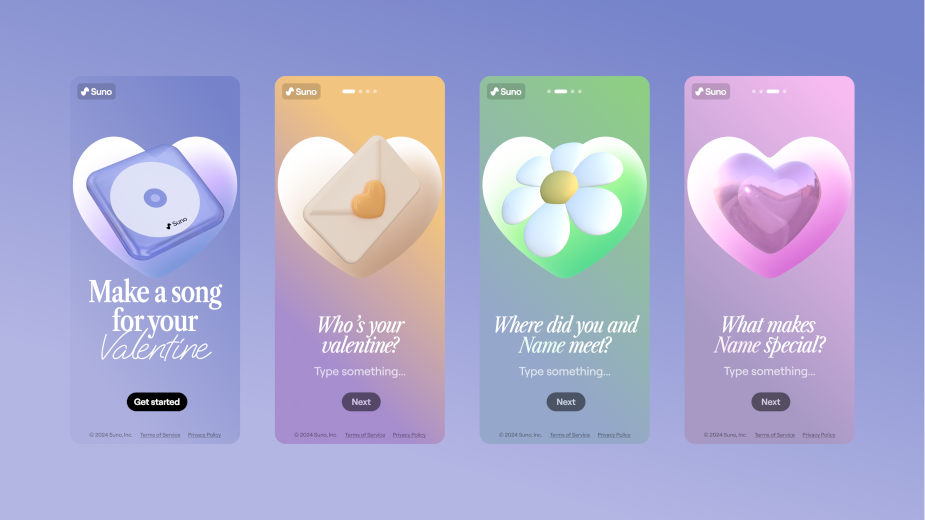
Source: Little Black Book
As for holiday season, Valentine’s Day is an opportunity for brands across all sectors to capitalize on the festive spirit by releasing limited edition products and redesigning their packaging. These special releases, ranging from beauty to food items, serve as simple but effective ways to engage consumers and drive sales.

Source: The grocer
For instance, Babybel celebrates Valentine’s Day with a heart-shaped mini variant of its iconic cheese. However, this special edition isn’t available for purchase in stores; instead, consumers must participate in a sweepstake on Babybel’s Instagram page to win it. This approach not only generates excitement but also amplifies the visibility of the limited edition.
Barilla celebrates Valentine’s Day by introducing heart-shaped pasta, accompanied by special recipes for a romantic evening. Meanwhile, Manly Man Co.‘s Meathearts puts a savory twist on the sweet candy hearts with playful messages like “MEET ME”.

Source: Barilla, Manly Man Co
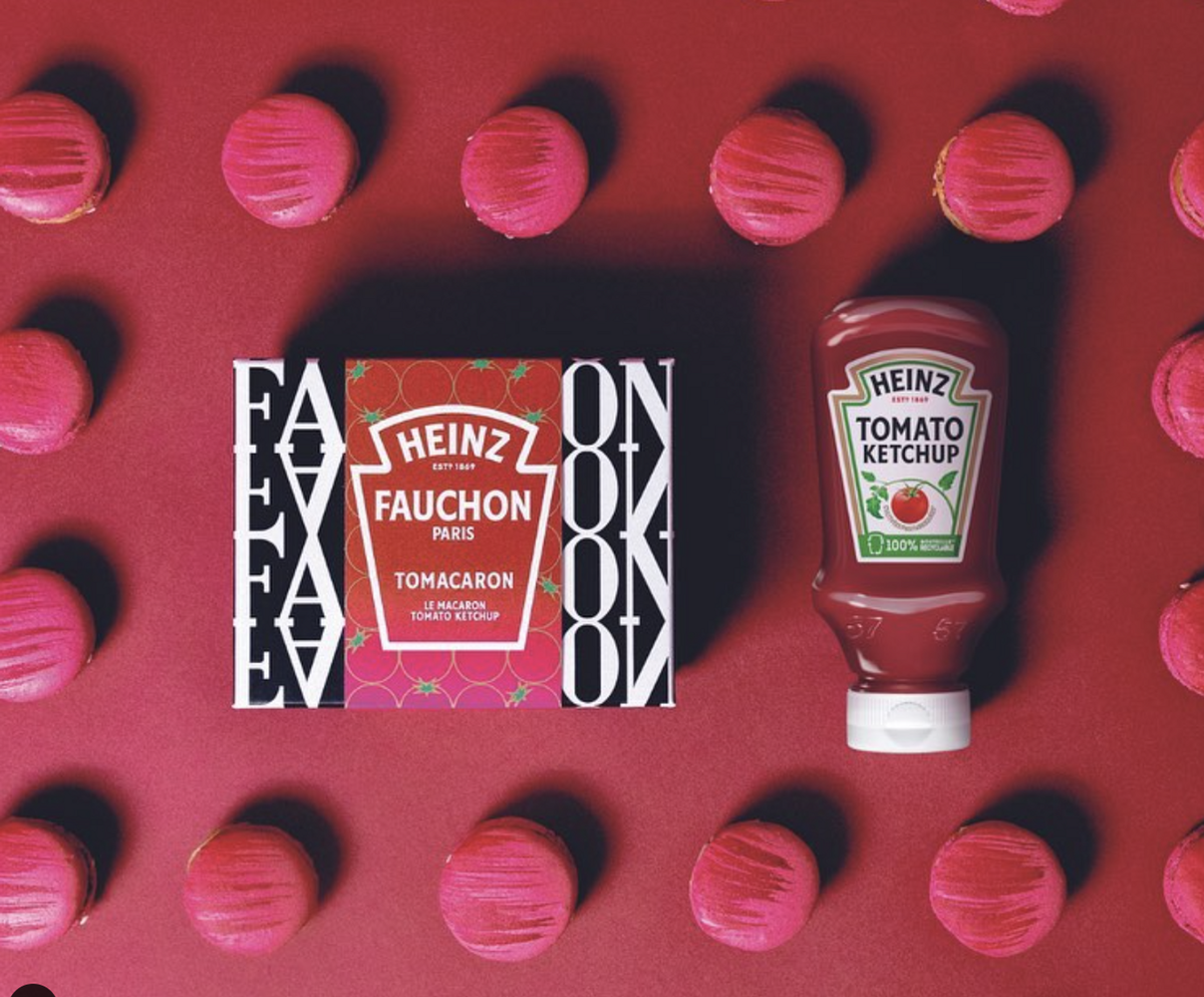
Source: Fauchon
Heinz celebrated the attraction of opposites with Fauchon Paris through the introduction of the Tomacaron: a macaron with ketchup. This limited edition isn’t just a culinary collaboration; it’s a testament to the power of collaboration that unlocked new opportunities to showcase their respective strengths, broaden their audience reach, and unveil a product that captures the imagination of consumers.
Thus, with the constant evolution of trends, technology, and consumer behaviors, brands have a wide range of options to capitalize on Valentine’s Day. They can leverage the latest technological advancements and emerging trends such as “situationships” and artificial intelligence, or opt for more traditional strategies like limited editions. By integrating these approaches in innovative and thoughtful ways, brands can strengthen their position in the market and foster lasting relationships with their audience during Valentine’s Day and beyond.
Holiday seasons like Valentine’s Day stand as pivotal moments for brands to cultivate consumer engagement and drive sales, leveraging the emotional resonance inherent on such occasions. Once a simple celebration of affection, February 14th has evolved into a grand marketing spectacle, wielding immense economic influence across diverse industries.
In fact, in 2024, Valentine’s Day expenditures in the United States are projected to soar to a staggering $26 billion (Statista, 2024). These figures underscore the burgeoning opportunity that this day represents for brands.
Therefore, it is legitimate to ask, how brands can leverage design strategies to maximize consumer engagement and drive sales during Valentine’s Day, as an opportunity to forge deeper connection with their audience.
Situationships.
In today’s dynamic landscape of relationships, the concept of “situationships” has emerged as a prominent phenomenon, especially among younger generations. According to a 2022 survey conducted by YPulse, 20% of Gen Z and 16% of Millennials report they have been in a situationship. And 35% of Gen z say they prefer to have an undefined relationship rather than one with a label, highlighting the evolving nature of modern love dynamics.
The campaign quickly gained traction on social media platforms, garnering over 1.2 million views on TikTok and sparking engagement from users who resonated with how confusing situationships can be. The brand’s website further extends the campaign’s reach with downloadable e-cards bearing phrases like “Do you know how much you mean to me? Because I don’t.” adding a touch of humor and authenticity to their Valentine’s Day strategy. This approach exemplifies how brands can adapt to evolving consumer behaviors and cultural trends, infusing their offerings with relevance and resonance.
Dating apps.
Today’s romantic landscape is inseparable from dating apps. With 2.3 million daily unique visitors to these platforms in France in 2023, dating apps have become an essential aspect of modern romance. Consequently, they represent a significant business opportunity for brands aiming to expand their audience reach, enhance visibility, and engage users in meaningful ways by addressing real-life challenges.
For example, Adidas and Bumble have collaborated to introduce a Gym Buddy Interest Badge on the dating app. This badge simplifies the process of finding potential gym partners who share a passion for staying active. The collaboration is in line with the launch of Adidas’s Spring/Summer 2024 Strength collection, showcasing the boundless potential of brand partnerships.

Source: Adidas
In another partnership, Tinder and Merci Handy have unveiled a capsule beauty collection named “First Date Heroes“. Inspired by an IFOP study for Tinder, which revealed that 74% of 18-25 year olds in France feel stressed before a date, this kit aims to ease the anxiety of first encounters. Additionally, 10% of proceeds from the collection are donated to Consentis, an association advocating for a culture of consent and combating sexual violence in social settings. This collaboration leverages Valentine’s Day as an opportunity to raise awareness of relevant issues and offer solutions that resonate with contemporary dating culture.

Source: Merci Handy
The increasing impact of AI is transforming how brands operate, presenting a new frontier in personalization and connection for both audiences and marketers. In the United States, 81% of consumers are open to AI providing personalized communications, underscoring the validity of its integration into communication and marketing strategies, especially evident during Valentine’s Day campaigns.

Source: Faire Savoir Faire

Source: Little Black Book
As for holiday season, Valentine’s Day is an opportunity for brands across all sectors to capitalize on the festive spirit by releasing limited edition products and redesigning their packaging. These special releases, ranging from beauty to food items, serve as simple but effective ways to engage consumers and drive sales.
For instance, Babybel celebrates Valentine’s Day with a heart-shaped mini variant of its iconic cheese. However, this special edition isn’t available for purchase in stores; instead, consumers must participate in a sweepstake on Babybel’s Instagram page to win it. This approach not only generates excitement but also amplifies the visibility of the limited edition.

Source: The grocer
Barilla celebrates Valentine’s Day by introducing heart-shaped pasta, accompanied by special recipes for a romantic evening. Meanwhile, Manly Man Co.‘s Meathearts puts a savory twist on the sweet candy hearts with playful messages like “MEET ME”.

Source: Barilla, Manly Man Co
Heinz celebrated the attraction of opposites with Fauchon Paris through the introduction of the Tomacaron: a macaron with ketchup. This limited edition isn’t just a culinary collaboration; it’s a testament to the power of collaboration that unlocked new opportunities to showcase their respective strengths, broaden their audience reach, and unveil a product that captures the imagination of consumers.

Source: Fauchon
Thus, with the constant evolution of trends, technology, and consumer behaviors, brands have a wide range of options to capitalize on Valentine’s Day. They can leverage the latest technological advancements and emerging trends such as “situationships” and artificial intelligence, or opt for more traditional strategies like limited editions. By integrating these approaches in innovative and thoughtful ways, brands can strengthen their position in the market and foster lasting relationships with their audience during Valentine’s Day and beyond.



